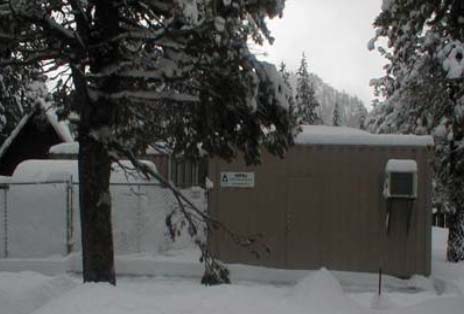
In 1998, after discovering the fuel additive MTBE in 13 of the community’s 34 drinking water supply wells, the South Tahoe Public Utility District adopted a zero-tolerance policy toward MTBE and shut down all of the contaminated wells. In 2002, the District reached a settlement with several responsible parties and was able to begin the daunting task of restoring its previously unspoiled drinking water supply. The District began this process by evaluating treatment for the Arrowhead #3 well, the first well targeted for restoration. At the end of its evaluation, the District purchased an 800-gpm HiPOx system that is able to reduce even the smallest concentrations of MTBE to below detectable limits (<0.2 ppb) without forming bromate, a byproduct which has plagued traditional advanced oxidation process (AOP) technologies. The HiPOx system was commissioned in June 2002, bringing the Arrowhead #3 well back into operation and delivering MTBE-free drinking water to the South Lake Tahoe community.

This HiPOx system became the first AOP system approved and permitted by the California Department of Health Services (DHS) to completely eliminate MTBE contamination in drinking water. Not only is the system housed in a weather-proof container, but it operates quietly, has a low profile, and does not require any waste removal or any other truck traffic through the residential neighborhood where it is installed.
The excellent performance of this HiPOx system lead the District to purchase an additional HiPOx system for installation at its Bakersfield well, the second of the 13 wells targeted for restoration. The Bakersfield well is contaminated with approximately 6 ppb MTBE and 9 ppb tert-butyl alcohol (TBA), a natural degradation product of MTBE. Like MTBE, TBA is highly mobile and spreads quickly in groundwater and it does not respond well to traditional treatment methods such as carbon and air stripping systems. In most MTBE-contaminated waters, TBA will eventually be detected. As with MTBE contamination, the District has adopted a zero-tolerance policy toward TBA in its water supply and has selected the HiPOx technology because it destroys both contaminants to non-detect levels. The new HiPOx system configured for the Bakersfield well will operate at flow rates ranging from 1,000 gpm to 1,500 gpm. This system was commissioned in June 2004.
We solve big environmental challenges and are always looking for like-minded people to join the APT family. We’d love to hear from you so drop us a note and tell us a little bit about yourself!
Subscribe to email updates